To LED or not to LED: Advertizing display technologies overview
Modern hectic life taught us to devour information in ever larger quantities. One TV set in an apartment is ridiculous. Two. Three. Not to mention PCs. Advertising displays in lift halls are getting quite common; displays can be seen in busses and taxis; most shops and supermarkets installed internal digital display networks; outdoor displays in public transport stops is a new trend.
The need to provide dynamic TV stream pushes businessmen, developers and designers to search for new video technologies. For the past 10 years LED screens became deeply rooted in our daily life. The LED technology continues to develop and transform: modern LED screens boast high pixel density, uniform high-contrast image, low energy consumption. However, LED technology is pressured on all sides by competitors who we should always keep in mind while thinking about advertising carrier technologies.
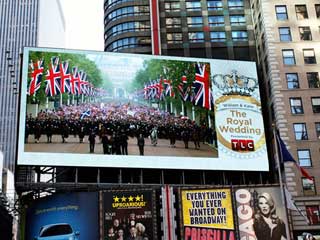 |
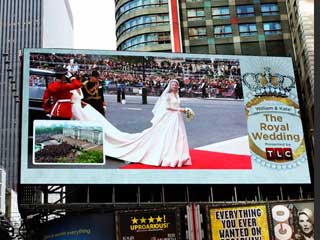 |
| Giant 4x HD resolution outdoor LED screen by D3 LED in Times Square with pixel pitch 10 mm Photo credit: D3 LED |
|
Initially, first challenge to indoor LED screens came from projection systems. However even with powerful projection lamps the resulting projected image turned out to be faded and failed to catch your breath away. The need to improve image quality led to specialized chemically treated screens (surfaces) with increased image contrast. An interesting solution was marketed as rear-projection screens that offered fairly good image quality. However, the steep price of screen surfaces, the need to set aside large empty space behind rear-projection screen and short life of powerful but expensive lamps ensured that they occupied only a limited market niche of conference rooms.
For a long time conventional TV screens could not enter into competition because of small sizes. The fight between Plasma panels and LCD displays seems to be over with the indisputable advantage of the latter. Especially with advent of new LCD displays with LED backlight. To increase image size companies started offering video-wall solutions. However without seamless technology the image broken into several rectangular pieces does not appeal to majority of clients.
But the efforts of developers were not in vain. The sizes of LCD displays started gradually to grow. Today, the largest LCD model reached 108” and apparently this is not the limit. Naturally, so far these displays are mostly installed indoor. However, as the new extra bright models appear the possibility of semi-outdoor installation is also explored by some companies. Today, TV screens maybe frequently seen behind the shop windows. Their contrast and brightness are already sufficient to attract attention of passers-by.
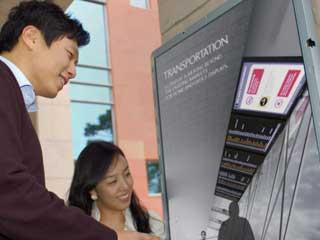 |
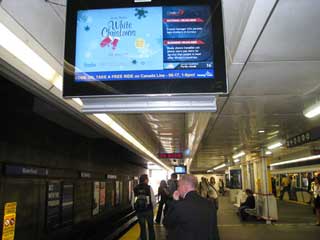 |
| 55” LG LCD panel with LED backlight and 2000 cd/m2 brightness Photo credit: gizmag.com |
LCD panels by Lamar Transit Advertising Photo credit: omnivex.com |
Christie MicroTiles technology aggressively attacks indoor advertising market. Apparently, if you are not against the segmented image (for example, Picasso-style image of a face broken into bits) Christie MicroTiles is an interesting solution. One of the indisputable advantages here is the possibility to cover with Christie screens (tiles) a surface of any shape, at times irregular and unusual. However, from the point of view of technical servicing Christie MicroTiles remain extremely cumbersome.
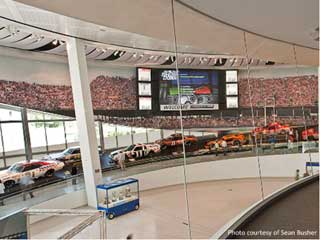 |
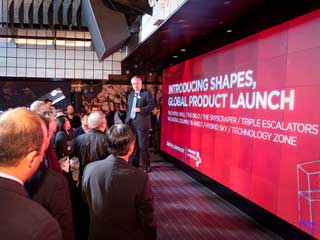 |
| Christie MicroTiles Fan Billboard in NASCAR Hall with 18x14 tiles and 7.2x4.2 m sizes Photo credit: Sean Busher |
Christie MicroTiles presentation Photo credit: saville.co.uk |
Magink technology attracted our attention long time ago in our article “Smart billboards attack!” Back in 2006 we wanted to believe in miracles expecting some new technology to surface and swipe LED screens away from the marketplace. Magink advertising sounded so sexy: low weight, low energy consumption due to reflective principle, tile structure with no size limit, relatively low price etc. Several years and several generations later Magink still remains a unproven and generally unwanted. Even their new stab at the popular 3D imaging failed to stir public interest. It seems that electronic paper has firmly established itself in our daily life (in the form of E-books) but failed to establish itself in the advertising market.
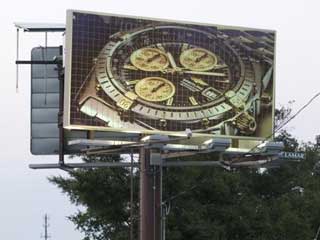 |
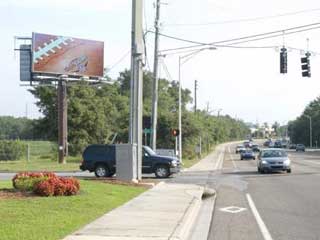 |
| Magink outdoor billboards Photo credit: Magink |
|
At regular periods new pretenders for the advertising supremacy surface. The latest is Prysm Inc. At the prestigious well-attended exhibition InfoComm in Las Vegas the company Prysm Inc. started an aggressive self-advertising campaign promoting its innovative LPD technology (Laser Phosphor Display) in the shape of TD1 screen. LPD is based on two main principles: laser projection (solid state laser diodes LD similar to those used in high-density optical storage devices) and a phosphor screen. The diodes emit lasers onto the phosphorous screen (glass or polymer) that boast high precision and can vary in intensity.
The phosphorous pixels (RGB) do not fade and maintain high brightness (up to 1000 nits which is sufficient for most indoor applications as well as for semi-outdoor use in downcast weather) all though 70 000 hours with an acceptable degradation level of 30%. The LPD display has an impossible 180 degree viewing angle, control system offers 240 Hz refresh rate and low energy consumption (in our energy-saving age no technology has a chance without these magical words). Based on 60-centimeter tiles the LPD display seems almost seamless, almost like a TV screen. It all sounds tempting but will this technology stand the test of time? And of course, the price is so far significantly higher than that of large LCD displays.
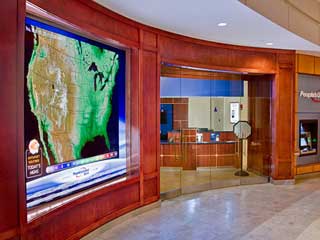 |
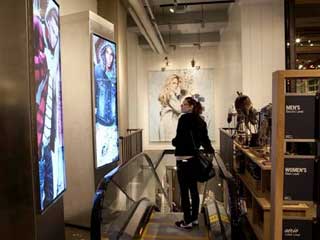 |
| Prysm LPD display in new branch of People’s Bank in Boston’s Prudential Center Photo credit: digitalsignageuniverse.typepad.com |
Prysm LPD display in American Eagle Outfitters new SoHo flagship store Photo credit: Business Wire |
It goes without saying that the market of TV screens and displays is very attractive. That is why every year brings news about some new and fresh innovation: FET (Field Emission Technology) based on Optronics developments, OLED (Organic light-emitting diodes), SED (Surface-conduction Electron-emitter Display) long expected Canon technology (recently R&D was suspended due to excessively high production cost).
The question is only which technology will pass the threshold of our domestic applications and become accepted by the advertising community. So far, this area is totally dominated by LED screens.





